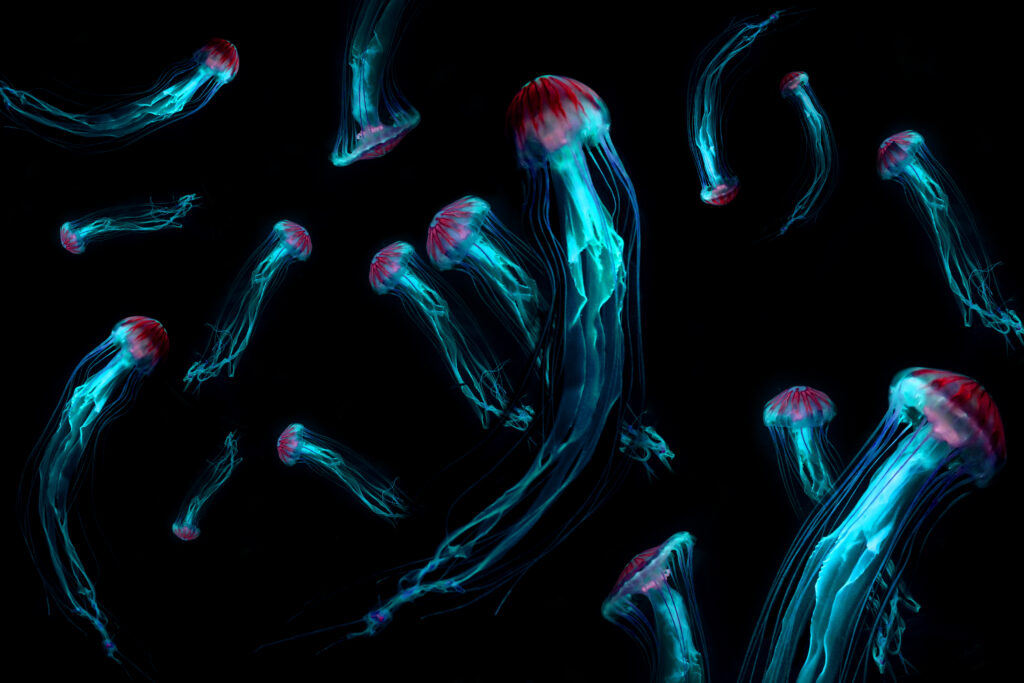1.) There are approximately 200 species of jellyfish on the planet. The oldest known fossils of Jellyfish have been found in rocks in Utah that are more than 500 million years old. Since the Jellyfish is a soft bodied animal, the fossil is an unusual discovery. Rather than leaving bones behind, these particular fossils were found deposited in fine sediment. This allowed them to leave behind more of a “fossil snapshot” of their bodies. The complexity of these early Jellyfish fossils seem to suggest that they either developed rapidly about 500 million years ago, or even older species developed long before that time. So it’s unclear as to when the diversification of the species to where we have about 200 different species now occurred.
2.) Free swimming scyphozoan jellyfish are found in all oceans, often found drifting along the shoreline where they feed on phytoplankton, copepods, fish larvae and other small marine species that they can catch in their tentacles. Their tentacles stun their prey. From there, they have an oral arm which then collects the food and then brings the food into the jellyfish’s mouth to consume. From their mouth, the food goes straight into their stomachs and that’s it! No, liver, no pancreas – they don’t even have intestines. Once the necessary nutrients are extracted from the food, the waste is then expelled back out of the mouth. Some species of jellyfish don’t even have an oral arm, they just free eat from the small animals and phytoplankton that enter their mouths.
3.) Most jellyfish live for less than one year. Some of the smallest species live for only a few days.

4.) Most species of Jellyfish’s bodies are 95% water. They do not have eyes, a heart or even a brain.
5.) A group of Jellyfish can go by 1 of 3 names: a bloom, smack or swarm.
6.) There are 3 stages to Jellyfish reproduction: Phase 1 is the medusa stage where the jellyfish release both eggs and sperm into the water which form a planula. These polyps then clone themselves and bud into the actual jellyfish which is called the ephyra stage.
7.) Over 60,000 jellyfish have been in space. In 1991 over 2,000 jellyfish polyps were put into space in order to see how the species would react to a lack of gravity. Not much of an effect was observed. In fact, those 2,000 jellyfish reproduce until over 60,000 jellyfish. When they were returned to Earth it was observed that they were not able to function properly. This also happens to some humans who spend a significant amount of time in space.
8.) There are over 25 species of Jellyfish that can be consumed by humans. Typically in a salad or picked form. It has been said that they have a salty taste and that their consistency is similar to noodles.
9.) Despite the majority of Jellyfish reported to have a short lifespan, the Turritopsis dohrnii – also known as the Immortal Jellyfish – can transform back into a polyp at will. This then produces a new, genetically identical jellyfish essentially rendering the species immortal.
10.) The sting of most species of jellyfish is no more harmful than an insect bite. While the level of toxin which results in the discomfort and reaction of the initial sting can vary from species to species, there are a few species that a sting can result in extreme pain to even death. For example, the Portuguese man-of-war sting is known to be extremely painful and in some rare cases it has resulted in death. In order to relieve a jellyfish sting, I usually bring a jelly fish sting product with me when I go snorkeling or scuba diving.
If you are stung, splash the area gently with water. Do not rub or scratch it as this could make it worse. Pouring something acidic onto the sting if you don’t have a product for it like vinegar, pepsi, coca cola or red wine will help to neutralize the sting. If you notice the area becoming extremely inflamed, seek medical attention right away as this can be an allergic reaction and will require medical intervention.
